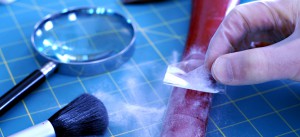

By Nicole Mayer
CHICAGO, IL – Attorney and forensic science expert Chris Fabricant passionately spoke about the impact of junk science in forensics, and how it leads to wrongful convictions and injustices in the American Criminal Justice System, in an interview by Attorney Rob Warren at the Printers Row Lit Fest recently.
Fabricant answered questions about his most recent novel, Junk Science and the American Criminal Justice System.
Attorney Fabricant is one of the nation’s leading experts in forensic science as well as the director of strategic litigation at the Innocence Project, which works to exonerate the wrongfully convicted using DNA technology and advanced forensic science. The goal of the project is to prevent future injustices in the criminal justice system.
At the start of his talk, he was asked, “Who is Lowell Levine?”
Fabricant briefly explained Lowell was the founding father of “bite mark” evidence, and that there “is a lot of analysis on bite mark science but not the pure manifestation of junk science.” Pushing further, he noted that junk science is involved with nearly half of all known wrongful convictions.
As explained thoroughly in the rest of his talk and his novel, Fabricant argues junk science leads to wrongful convictions in that it is not empirical, researched, scientific data.
One of the most common examples of junk science used in criminal history is bite mark analysis, he said, noting the significance of junk science in a positive light, in that it helps identify many victim’s bodies when they are burned past recognition. Dental records are used to identify the bodies.
He additionally acknowledged it can be important and immensely persuasive in court cases, especially big ones.
In his novel, Fabricant mentions one case where bite mark analysis positively impacted the conviction: the infamous Ted Bundy. As the first nationally televised criminal trial in history, the court relied heavily on bite mark analysis to convict Bundy.
Amazingly, Lowell Levine was the dental odontologist who identified Bundy’s teeth in the trial, matching his dental records to the bite marks on one of the victims. Fabricant explains that they most likely convicted the right man, but Lowell truly did not have much “evidence to really scientifically match it to anybody.”
Brushing past this, Fabricant dug up one of the Innocence Project’s early cases, in which Lowell’s testimony of bite mark analysis displayed precedent scientific uncertainty.
Keith Harward, Fabricant remembered, was wrongfully convicted of murder and sexual assault in the summer of 1982.
As a young sailor working aboard the USS Carl Vincent, docked in Newport News, Virginia, Harward was arrested for breaking into a young couple’s home, and murdering the husband along with sexually assaulting and torturing the wife.
There were no fingerprints or eyewitnesses at the crime scene; the only available evidence was bite marks on the surviving female’s thigh, said Fabricant.
Piecing together a snapshot of the alleged murderer based on described features by the victim, it kicked off the greatest dental dragnet in history, he said.
An investigation began in Newport News, looking into the other sailors docked there at the time.
After being arrested for getting into a violent drunk fight with his girlfriend, it was found that Harward bit his girlfriend multiple times on the shoulder. When in trial, Levine testified against Harward, claiming he was guilty based on bite mark analysis.
Solely by the fact that he was a “biter,” explained Fabricant.
After 34 years spent in prison, Harward was exonerated by the Innocence Project, after the real killer was found—John Crotty—using forensic science and new DNA technology.
Crotty’s DNA was found all over the apartment and in the rape kit. Also a sailor at the time with similar physical features, Crotty was also found guilty of other crimes.
Fabricant mentioned something not included in the book—he met Lowell at the previous conference for the American Academy of Forensic Sciences. Fabricant recalled that Lowell continued to doubt Harward’s innocence and stood by the bite mark analysis.
Fabricant said, due to this disagreement of evidence, they no longer speak.
Even though he said parts of junk science have some positive impacts, Fabricant maintains it’s “poor people science” and said the court system seems to employ one arrangement: to find experts in civil cases against the wealthy corporate defendants with limited resources.
Overall, Fabricant argues junk science can unintentionally enable a harmful precedent in the criminal system, more often than not resulting in the wrongful conviction of many innocent people.